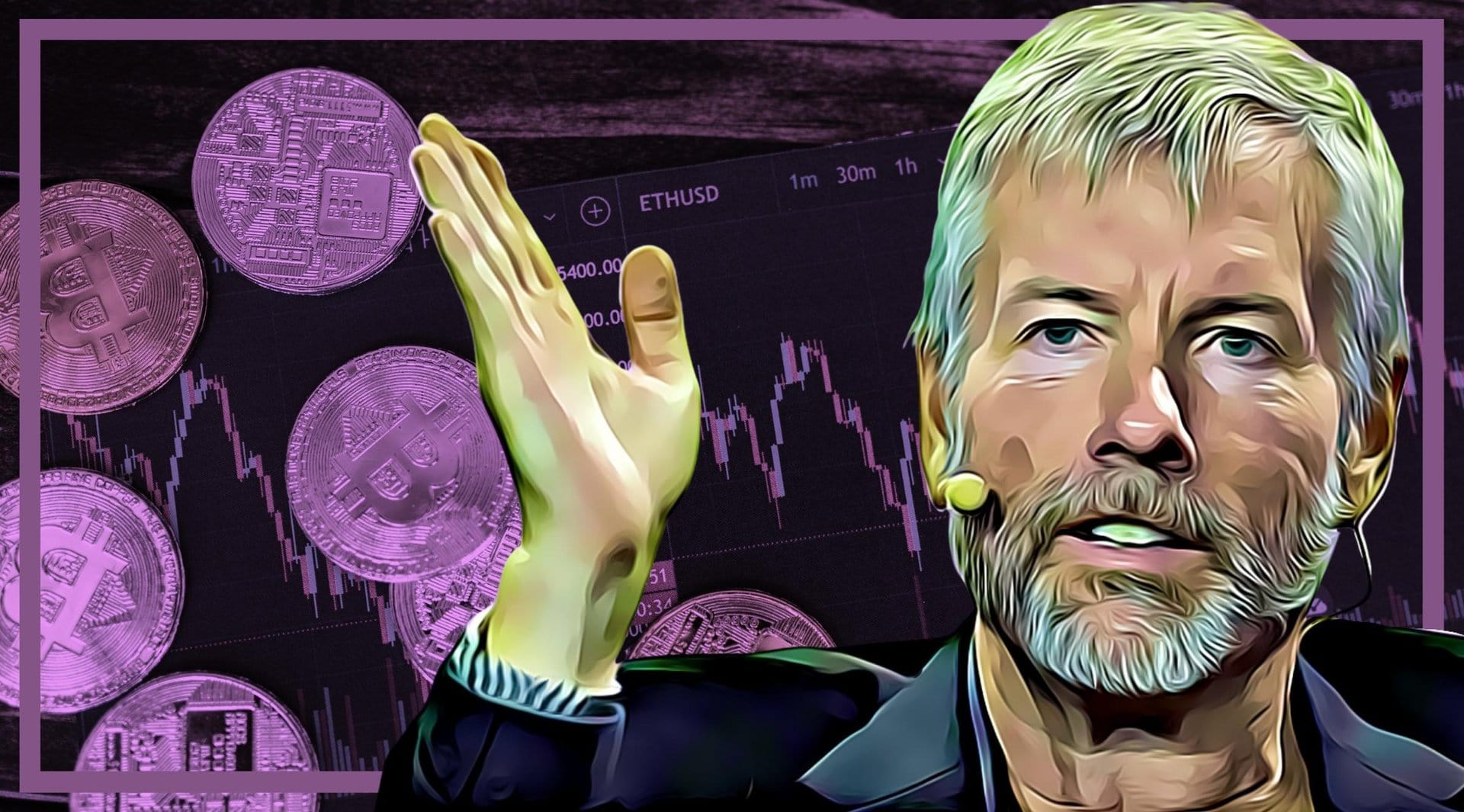Michael Saylor is begging the government to intervene to save his bitcoin investment, insisting he will never sell his hoard, not that he really could at this point. As of the end of March, he holds 129,218, at an average price of $30,700.
That is unless his company, MicroStrategy, faces the mother of all margin calls, which could happen if the digital asset falls low enough. In March, MicroStrategy borrowed $205 million from Silvergate Bank so they could buy more bitcoin with part of its holdings as collateral.
Phong Le, current President and former CFO, said that when the price hits $21,000, the company may face a margin call. Projecting calm, Saylor put the price floor at $3,562 before the company would run out of crypto to pledge. But not to worry, there will be no firesale! Saylor insists his firm has a ten-year time horizon in its investment strategy.
To underline the point, Saylor just doubled down. Between March and June, Saylor added another 480 bitcoin for $10 million, putting the total at 129,699.
Things aren’t going great for MicroStrategy, which is having the worst year since 2000, when its share price went from $313 to $4.09, in what the Washington Post termed “an amazing tale of hubris, hyperbole, and high-tech hallucinations.” MicroStrategy was ranked as the biggest loser of the entire dotcom bubble, and the SEC accused Saylor of fraud.
Saylor Projects Calm, Writes Slam Poetry
It sucks to be Saylor at the moment. His company’s bitcoin hoard was worth $5.9 billion at the end of last quarter, but then it tumbled 58% down to $2.45 billion in just three months. After spending $4 billion on the digital asset, this year’s crash wiped away $3.5 billion (and counting) from Saylor’s own personal wealth. His own store of bitcoin has gone from $1.22 billion to $350 million, and his holdings of MicroStrategy shares, previously worth nearly $3 billion, have spiraled downward to $355 million, after losing 66% of their value.
Despite these sobering losses, you wouldn’t know Saylor is fighting for his life from his Twitter feed or his frequent appearances on business news. According to Saylor, bitcoin is “Freedom,” “a modern miracle,” and “the most universally desirable property in space and time.”
A bitcoin slam poem is pinned to the top of his Twitter timeline:
#Bitcoin is a swarm of cyber hornets serving the goddess of wisdom, feeding on the fire of truth, exponentially growing ever smarter, faster, and stronger behind a wall of encrypted energy.
— Michael Saylor⚡️ (@saylor) September 18, 2020
Regulators are just trying to decide whether bitcoin is a security or a commodity, but Saylor has the answer! It’s a swarm of cyber hornets serving the Goddess of wisdom. Welp, glad we have that sorted out!
Blood in the Water
However, behind the amateur slam poems, I detect fear in his public statements; otherwise, Saylor wouldn’t be squealing so loudly about all the bad actors who are sabotaging the ecosystem. Observe his recent statements:
“The general public shouldn’t be buying unregistered securities from wildcat bankers that may or may not be there next Thursday.”
“The crypto exchanges, offshore and onshore, are unregistered, unregulated and offer 20x leverage; they don’t have mature Chinese walls.”
“The people are confused about what’s a currency, what’s a commodity, what’s a security, what are tokens. There’s 19,000 cryptos out there. I think we can see in the crypto crash that the average investor’s been taken advantage of by traders and wildcat crypto banks.”
However, this bit is especially informative: “any form of regulation is gonna be good,” the bitcoin slam poet preached to Fox Business, a stringently anti-regulation outlet.
After investing 100 hours we all come to realize that #Bitcoin is 100x bigger than the next best digital commodity network and utterly unique. I take the long view in my cheerful, constructive conversation with @cvpayne as we talk BTC & debunk the critics.pic.twitter.com/YeqzfVd8xB
— Michael Saylor⚡️ (@saylor) June 21, 2022
Saylor himself doesn’t believe in government intervention in the free market, either, but the “slime” that has invaded the market of digital assets puts legitimate HOLDers at risk.
Bitcoin is still digital gold, Saylor insists, calling the other 19,000 cryptocurrencies a “$400 billion cloud of opaque, unregistered securities trading without a full and fair disclosure.”
But not bitcoin, Saylor prophesies. “It’s fundamentally different than anything that’s come before it,” he told CNN in an interview he tweeted along with another prose poem.
#Bitcoin is a lifeboat, tossed on a stormy sea, offering hope to anyone in the world that needs to get off their sinking ship. We are witnessing the birth of a new industry during the worst financial crisis of our lifetime. My interview w/@jchatterleyCNN pic.twitter.com/P2QJWgyf0S
— Michael Saylor⚡️ (@saylor) June 22, 2022
Regulation is needed, he explains, to catapult the market “from the entrepreneurial, offshore anything-goes stage into an institutional, mature asset class.”
Okay, great, but wait: many old-school HOLDers will be disappointed with the institutionalization of bitcoin. The anything-goes aspect of digital assets was exactly what they liked about it.
To Swim with the Sharks, One Must Have the Appetite of a Whale
Unfortunately, MicroStrategy’s position in bitcoin introduces a dangerous level of centralization into an ostensibly decentralized market. Whales, the 1,000 people who own 40% of the market, destabilize price levels and endanger whole exchanges. In the last year, whales swallowed another 5.6% of the total supply, making their share 45.6%.
That’s why Solend, a decentralized protocol for borrowing and lending Solana, recently tried to take over a massive whale account whose holdings account for 95% of SOL deposits in the protocol’s pool. For bitcoin, a mere 82 wallets hold nearly 15% of the total supply, and three wallets hold more than 575,000 bitcoin, worth around $11.5 billion currently.
When whales buy the dip, they can sell when the price goes up, screwing over the sad retail saps who have ignorantly chased the herd. They hold the market in their hands and they can crash it. But not Saylor, he’s not selling anytime soon.
Brokerages Say “Buy”
Maybe Saylor’s nonstop crypto-cheerleading has something to do with why three of the four brokerages that focus on MicroStrategy still recommend buying the company’s paper, even at a price point three times higher than where the share price currently slumps.
The only non-bull is Brent Thill of Jefferies who rates the stock as a ‘hold’ with a price target of $180, saying that management needs to focus on the core software business. MicroStrategy was a business intelligence, mobile software, and cloud-computing company, but now it’s basically one big bet on bitcoin.
Any company throwing more good money at a security heading into a trough would normally not be recommended by any self-respecting analyst, so when exchanges like Celsius and Coinflex are stopping withdrawals and crypto hedge funds like Three Arrows Capital are defaulting on their loans, why are brokers so bullish on MicroStrategy?
Nobody talks about its “core” software business, and there’s no mystery as to why: it’s boring. Reviews of the product say it’s basically fine, although the interface makes some users feel “transported back to 1996.”
Although revenue grew by 3%, MicroStrategy didn’t make a profit in the last twelve months and its share price declined by 63%. Maybe, the market overreacted and there will be a correction, which leads to the inference that the stock may be undervalued. Insiders buying the stock over the last quarter must have a reason, besides the CEO’s scintillating slam poetry. Some insiders may invest in MicroStrategy to get exposure to bitcoin, which Saylor has recommended.
Stacking Bitcoin with Debt
Over the past two years, Saylor has pursued a Dollar Cost Averaging (DCA) investment strategy, using debt to buy bitcoin in bulk at favorable prices. If you want to understand how DCA works, read this post, but the upshot is that if you take out a loan and invest when the price is around $25,000, the price would only need to rise to $35,000 to pay a 10% interest rate. After that, you would come out on top.
In the long run, Saylor may come out on top, but MicroStrategy is currently hemorrhaging. Recently, the company transferred more than 2,000 bitcoin worth $48 million to a new wallet, which some have suggested may intend to sell soon.
MicroStrategy has just transferred 2089 #Bitcoin ($48 million) to a new wallet for the first time ever, likely planning to dump their bags.
— CryptoWhale (@CryptoWhale) June 13, 2022
They’re now moments away from facing the largest liquidation in history. Ouch. pic.twitter.com/06NWFYFa4N
It’s not clear that MicroStrategy is actually preparing to sell, but they aren’t officially dispelling the rumors, either.
Hyperbitcoinization Versus Hyperinflation
There may be a larger long-term problem in Saylor’s bitcoin investment strategy: It’s based on a logical fallacy. As John Tamny garrulously explains in Forbes, Saylor has compared bitcoin to gold and oil, but he says bitcoin is better than both because it is limited in its supply.
There are and will only ever be 21 million bitcoin in circulation, meaning they are marked by scarcity and will therefore always increase in value. In this way, bitcoin is not like the dollar, which is experiencing inflation right now, but because of this, it also cannot ever really be useful as money. Why would we spend what will rise in value?
Yet part of the bitcoin thesis is that it will replace fiat currencies in a process referred to as hyperbitcoinization. This process happens as people around the world realize that bitcoin is superior to fiat currencies during bouts of hyperinflation and switch to bitcoin as both a medium of exchange and a store of value.
At that point, the “bitcoin circular economy” will take shape in which all goods and services will be available for BTC, and the economy will become deflationary, meaning the currency grows in value, rather than decreases.
Whales in The Way
Despite the obvious macroeconomic problems deflation poses for producers of goods and services, as well as policymakers, this is the revolutionary idea that has captured the minds of millions, but bitcoin whales like Michael Saylor actually stand in the way of hyperbitcoinization.
No third party, no celebrity, or market actor was supposed to control the destiny of bitcoin. Yet the bitcoin faithful inevitably rally around the latest corporate bitcoin shill, seeming to forget that this is the whole reason why Satoshi Nakamoto disappeared!
By hoarding almost as much bitcoin as the largest bitcoin whale’s wallet, Saylor contradicts his oft-professed reason for wanting to be involved. If bitcoin did become the dominant medium of exchange, it would eventually cease to be useful for his get-rich-slow strategy. Edward Moya, a Senior Market Analyst in OANDA, doesn’t recommend MicroStrategy, telling Blockworks:
The rapid appreciation before last year’s record high and latest demise shows MicroStrategy has failed to capitalize on the way up and to find protection when things got ugly. Investors looking for crypto exposure should not consider MicroStrategy a good vehicle for that as they have proven to be reckless with their portfolio management.
Instead of investing in MicroStrategy as a vehicle, there are other ways for investors to get exposure to bitcoin, using index funds, Tesla, and ETFs like the ARK Invest Innovation ETF, although all come with risks. Most experts recommend investing less than 5% of your total portfolio in digital assets.
Although he has called for other companies to treat bitcoin as a treasury reserve asset, Saylor may end up riding the wave and cashing out just like any other pump-and-dump investor. However, he is not alone. Some of the most respected money managers in the world like Ray Dalio, Stanley Druckenmiller, and Paul Tudor Jones, are embracing bitcoin.
Furthermore, data from IntoTheBlock shows that whales are quietly stuffing their bitcoin coffers like it’s crypto Christmas. Perhaps, the rumors of the so-called bitcoin winter are overblown.
Author: Tim Tolka, writer, journalist, and BI researcher
The editorial team at #DisruptionBanking has taken all precautions to ensure that no persons or organizations have been adversely affected or offered any sort of financial advice in this article. This article is most definitely not financial advice.
















2 Responses
What absolutely stuns me – yet, paradoxically I suppose explains perfectly how the bitcoin evangelist’s mind works – is the fact that we, as a global community, have just experienced the sort of event that illustrates beyond a shadow of a doubt why hyperbitcoinization not only will never happen, but shouldn’t be on anyone’s wish list to begin with.
Imagine responding to Covid not with a flexible, fiat currency, but with an absolutely limited supply of bitcoin. Assuming first of all that some sort of distribution event has taken place and thus nation states are not beholden to whales like Saylor for their stash of btc, how does any gov’t. pay their workforce to stay home, pay businesses in lieu of lost revenues and fund vaccine research and development on top of their existing day to day expenditures? Bitcoiners love to shill btc as a cure for inflation, but in any realistic scenario the first result of a covid-type event would be the absolute skyrocketing of prices for everything as the populace attempts to grab their share of the ‘money’ supply before it disappears.
And what happens when it inevitably does just that? People die on the streets either from covid or starvation.
The article points out that Saylor’s gamble on btc is built on the logical fallacy of hyperbitcoinization; I would argue that 99% of btc doctrine is built on the logical fallacy of a deeply erroneous misunderstanding of what money is and what it does. Bitcoiners are like people arguing that oranges are better apples than apples themselves because apples aren’t oranges. At this point all I really care about is that Saylor doesn’t crash the entire crypto sphere the way he trashed dot.com 20 years ago. Crypto has a lot to offer, certainly more than just bitcoin.
Dude, nobody claims BTC should replace fiat. It’s a store of value, can even be used to buy stuff but the main accounting will stay in fiat. Same as gold, really.